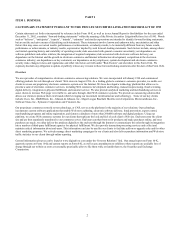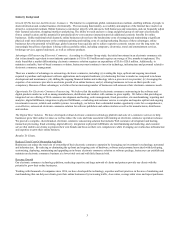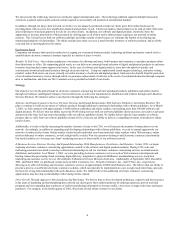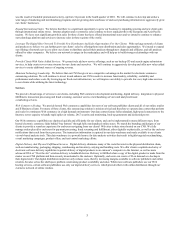Digital River 2002 Annual Report Download - page 18
Download and view the complete annual report
Please find page 18 of the 2002 Digital River annual report below. You can navigate through the pages in the report by either clicking on the pages listed below, or by using the keyword search tool below to find specific information within the annual report.12
RISK FACTORS
In addition to the other information provided in this report, stockholders or prospective investors should carefully consider the following risk
factors:
We have a limited operating history, a history of losses and we have yet to achieve sustained profitability.
We were incorporated in February 1994 and conducted our first online sale through a client’ s Web store in August 1996. We have not yet
achieved sustained profitability and have incurred significant losses since we were formed. As of December 31, 2002, we had an accumulated
deficit of approximately $104 million. Our limited profitable operating history makes it difficult for you to evaluate our ability to sustain
profitability in the future.
The success of our business model depends upon our success in generating sufficient transaction and service fees from the use of our electronic
commerce solutions by existing and future clients. Accordingly, we must maintain existing, and develop new relationships with software
publishers, online retailers and E-Business clients. To achieve this goal, we intend to continue to expend significant financial and management
resources on the development of additional services, sales and marketing, improved technology and expanded operations. If we are unable to
maintain existing, and develop new, client relationships, we will not generate a profitable return on our investments and we will be unable to
gain meaningful market share to justify these investments. Further, we may be unable to achieve profitability if our revenues increase slower
than expected, or if operating expenses exceed our expectations and cannot be adjusted to compensate for lower than expected revenue volumes.
Even if we are able to achieve profitability on an annual basis, we may be unable to sustain or increase this profitability on a quarterly or annual
basis.
Our operating results have fluctuated in the past and are likely to continue to do so, which could cause the price of our Common Stock
to be volatile.
Our quarterly and annual operating results have fluctuated significantly in the past and are likely to continue to do so in the future due to a
variety of factors, some of which are outside our control. As a result, we believe that quarter-to-quarter and year-to-year comparisons of our
revenue and operating results are not necessarily meaningful, and that these comparisons may not be accurate indicators of future performance.
If our annual or quarterly operating results fail to meet the guidance we provide to securities analysts and investors or otherwise fail to meet
their expectations, the trading price of our Common Stock will likely decline. Some of the factors that have or may contribute to fluctuations in
our quarterly and annual operating results include:
• our ability to attract and retain software publishers and online retailers as clients;
• our ability to attract and retain E-Business clients;
• the introduction by us of new Web sites, Web stores or services that may require a substantial investment of our resources;
• the introduction by others of competitive Web sites, Web stores or services;
• our ability to continue to upgrade and develop our systems and infrastructure to meet emerging market needs and remain competitive
in our service offerings;
• economic conditions, particularly those affecting Internet-based electronic commerce;
• client decisions to delay new product launches or to invest in e-commerce initiatives;
• national and international political unrest in connection with the continued military responses to the terrorist attacks on the United
States, possible future terrorist attacks and the growing threat of war;
• the performance of our newly acquired assets or companies;
• technical difficulties or system downtime leading to termination of client contracts and harm to our reputation;
• slower than anticipated growth of the online market as a vehicle for the purchase of software products;
• the cost of compliance with U.S. and foreign regulations relating to our business; and
























